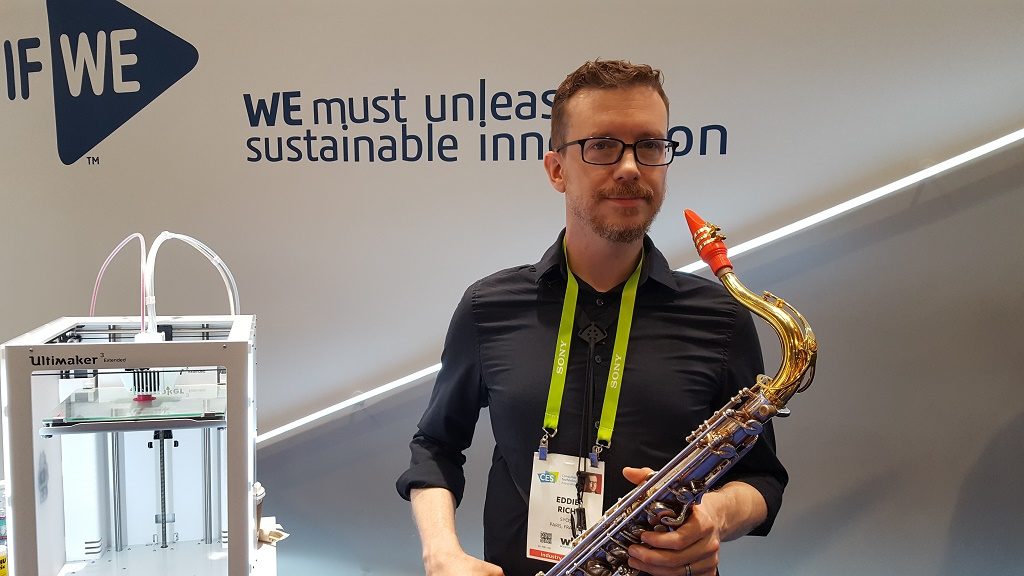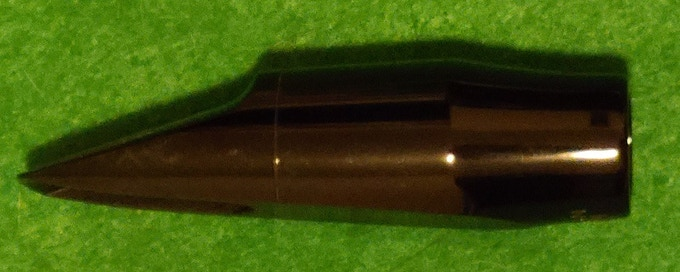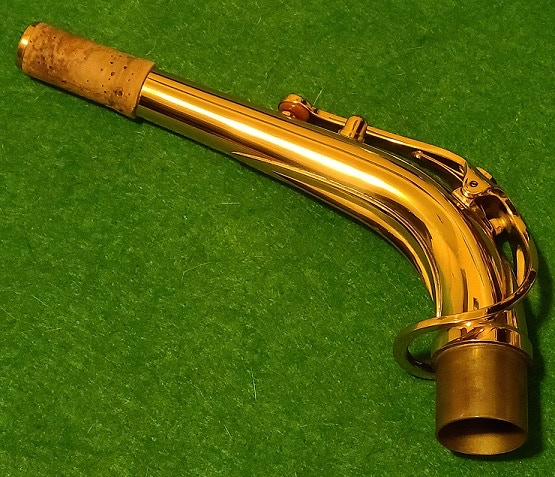I’ve been playing music in some form or fashion since I was in the first grade, from singing and ringing handbells in various church choirs, taking piano lessons, and playing flute in the high school marching and concert bands to rocking out on the marimba in our school’s indoor winter percussion ensemble. So, whenever I hear a story about 3D printed instruments, my ears perk right up.
North Carolina-based data analytics consultant Joe McGuire has been playing the saxophone for over 30 years, and is passionate about sharing his love of music with students young and old through his YouTube channel, Advanced Saxophone Lessons Made Easy (ASLME). He is also, it seems, a fan of 3D printing.
About a month ago, he launched a Kickstarter campaign for a high-quality, professional, yet affordable 3D printed alto sax, in order to, as the campaign states, “make music accessible to a much wider demographic.”
“Even at the beginner level, saxophones are expensive. Many students are unable to afford an instrument to begin learning music on, and those who settle for a lesser quality instrument can quickly become discouraged and lose interest in creating music. For those who stick with music into high school and college, affording a higher quality instrument is even more challenging. Top-of-the-line alto saxophones retail for over $4,000,” McGuire explained in the campaign. “Performing music on a quality instrument is a very rewarding experience that few can enjoy. I would like to change this by providing a quality instrument for little or no cost to those who desire this experience for themselves.”
However, if you check out the video below, you can see that opinions on playing high-quality saxes differ a little. For example, Jay Metcalf of the Better Sax YouTube channel pitted his professional Yanagisawa A991 alto sax against one he bought on Amazon for less than $300, and found that the cheaper instrument, while obviously of lesser sound quality, was able to hold its own.
Some saxy background: even though the instrument is typically made out of brass, it’s part of the woodwind family because the sound is produced through a reed, usually made of woody cane, rather than vibrating your lips in a mouthpiece cup like other brass instruments. With woodwinds, the pitch of a note is controlled by covering holes in the body of the instrument through the pressing of keys. These holes serve to control the air column’s resonant frequency. There are several types of saxophones, but the most common are the alto, baritone, and soprano saxes.
“My decades of practicing, performing on, and teaching the saxophone have provided a great understanding of how the many parts of a saxophone work together to make an incomparable sound,” McGuire wrote.
His goal with this Kickstarter is to design, 3D print, assemble, and distribute high-quality alto saxophones to a variety of musicians, from aspiring, inner-city players to the most expert of virtuosos. Unfortunately, the campaign doesn’t seem to be going well. It ends this Saturday, October 31st, and McGuire has only raised $511 of his $5,450 goal. If he somehow manages to raise all of the funds by this Saturday, the money will be used to cover production and distribution costs, but mostly to purchase a high-quality 3D printer and a variety of filaments, which he will test out to find which material will be optimal for making the sax parts.

Las Vegas musician Eddie Rich playing a sax with a 3D printed mouthpiece at CES 2018. (Image courtesy of Sarah Goehrke for 3DPrint.com)
Olaf Diegel made a 3D printed saxophone using Duraform PA nylon powder, while Taiwan’s Industrial Technology Research Institute (ITRI) printed one a year later out of titanium alloy powder, and French company Shape Your Own Sound (SYOS) 3D prints sax and clarinet mouthpieces using ABS plastic. There are obviously multiple options, so I’m not sure which direction filament-wise McGuire would go with his project. Regardless, he’s estimating that the time from design to final 3D printed sax to distribution will be between eight months and a year.
The first objective in his Kickstarter campaign will be to design and 3D print an alto sax mouthpiece that “rivals those from the leading manufacturers.” McGuire says that while the outer part of the mouthpiece looks “rather straightforward,” how the interior is formed will really impact the sound. A friend of mine from college, who has some experience with 3D printing and is an accomplished sax player himself, can vouch for this. He told me he tried a 3D printed mouthpiece for his instrument, which did not go well because he wasn’t able to get the correct geometry or accomplish an airtight seal on the actual printer. He managed a few squawking noises, but that was it. But McGuire seems confident that once he’s tested his as yet un-purchased printer with different designs and materials, he should be able to finish the mouthpiece in less than four months.
The next part of the project will be designing the neck, which seems difficult to me because of its more complex design feature: the small hole at the top of the neck must be completely open sometimes and completely sealed at others.
“The “octave key” will control whether the hole is open or closed, which in turn determines if the sound is in the upper octave (high notes) or lower octave (low notes), respectively,” McGuire explained.
Even so, the estimated time for designing and 3D printing the neck of the alto sax is about 1-2 months.
The most challenging part of the design, and the 3D printing, will be the body of the saxophone, which tracks with what another skilled sax-playing friend of mine said: “The hard part will be the keys.” The hollow tube of the instrument features 25 tone holes, each of which must be “perfectly rounded for the optimal response.” McGuire will be 3D printing small screws in order to attach the keys, each to be printed separately, that will cover the tone holes.
“Once the design and sufficient testing for determining the ideal filament are complete, the many keys, screws, and other various parts can be printed and arranged in a logical way to allow for a relatively quick assembly,” McGuire wrote. “While the design may only take a few months to complete, getting to the desired final product may take several additional months of thorough testing. I’m hopeful the body can be completed in 6 to 8 months.”
Again, this is all contingent upon whether or not he makes his Kickstarter goal. If you find this project interesting, you can pledge $10 for no reward, or pledge $40 to receive a personal thank you note from McGuire. A $125 pledge will get you the first working 3D print of his mouthpiece, and for $250, McGuire will print any design that you choose (within reason) and send it to you.
The big question here is this: would a 3D printed saxophone be viable? I don’t know the answer to that. I mentioned earlier that an accomplished sax player tested out a cheap sax against his own expensive, professional one, and found that it performed decently…if you’re a beginner, that’s really all you need, and accessibility to good instruments is what McGuire is trying to achieve. But what about the professionals who shell out thousands to buy the best of the best? Would a 3D printed sax cut the mustard, so to speak?
Above is a video from 2009 that shows how a saxophone is traditionally manufactured. At one point in time, the methods used there were also brand new, just as 3D printing once was, so part of me thinks, if we’re able to scan and print patient-specific dental aligners and hearing aids, surely the technology can handle a musical instrument. But on the other hand, Laurent Lacombe, the co-founder of Creadditive, acknowledged that the sound his 3D printed violin made was not identical to the sound a traditional hand-crafted violin would make, and Ottawa Symphony Orchestra concertmaster and violin teacher Mary-Elizabeth Brown said the instrument she tried “had a different kind of soul” than her own violin. So in my humble opinion, the viability of 3D printed instruments is still up for debate.
Subscribe to Our Email Newsletter
Stay up-to-date on all the latest news from the 3D printing industry and receive information and offers from third party vendors.
You May Also Like
3D Printing Unpeeled: New Arkema Material for HP, Saddle and Macro MEMS
A new Arkema material for MJF is said to reduce costs per part by up to 25% and have an 85% reusability ratio. HP 3D HR PA 12 S has been...
3D Printing News Briefs, January 20, 2024: FDM, LPBF, Underwater 3D Printer, Racing, & More
We’re starting off with a process certification in today’s 3D Printing News Briefs, and then moving on to research about solute trapping, laser powder bed fusion, and then moving on...
3D Printing Webinar and Event Roundup: December 3, 2023
We’ve got plenty of events and webinars coming up for you this week! Quickparts is having a Manufacturing Roadshow, America Makes is holding a Member Town Hall, Stratafest makes two...
Formnext 2023 Day Three: Slam Dunk
I’m high—high on trade show. I’ve met numerous new faces and reconnected with old friends, creating an absolutely wonderful atmosphere. The excitement is palpable over several emerging developments. The high...


































